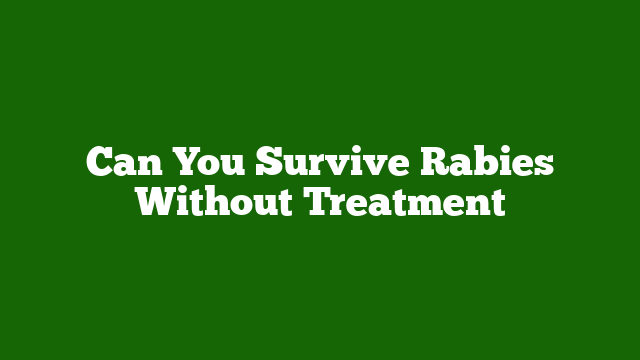Last Updated on June 12, 2023 by Umar
Rabies is a viral disease that affects the central nervous system, causing severe neurological symptoms and, ultimately, death.
The question of whether one can survive rabies without treatment is a critical one, as the disease has a nearly 100% fatality rate once symptoms appear.
In this comprehensive blog post, we will explore personal stories, research, and statistics to provide an in-depth understanding of the chances of survival without treatment.
Personal Stories
Unfortunately, we were unable to find personal stories of individuals surviving rabies without treatment.
This is likely due to the extremely low survival rate of the disease once symptoms manifest.
However, there have been a few rare cases of survival with treatment, which we will discuss later in this post.
Rabies: A Brief Overview
Rabies is transmitted through the saliva of an infected animal, typically via a bite or scratch.
The virus travels through the nerves to the brain, where it multiplies and causes inflammation.
Symptoms of rabies include fever, headache, muscle weakness, and tingling at the site of the bite.
As the disease progresses, more severe symptoms such as confusion, agitation, hallucinations, and paralysis may occur .
The Importance of Prompt Treatment
Once symptoms of rabies appear, the disease is almost always fatal.
However, if treatment is initiated promptly after exposure, the chances of survival are significantly higher.
The treatment for rabies exposure is called post-exposure prophylaxis (PEP) and consists of a series of vaccinations and, in some cases, a dose of rabies immune globulin .PEP is highly effective in preventing the onset of symptoms and subsequent death if administered soon after exposure.
It is crucial to seek medical attention immediately after a potential exposure to rabies, as delaying treatment can have dire consequences.
Rare Cases of Survival
There have been a few documented cases of individuals surviving rabies with treatment, even after the onset of symptoms.
One such case is that of Jeanna Giese, a Wisconsin teenager who was bitten by a bat in 2004.
Jeanna did not receive PEP, and she developed symptoms of rabies a month later.
Doctors treated her with an experimental protocol known as the Milwaukee Protocol, which involved placing her in a medically induced coma and administering antiviral medications.
Miraculously, Jeanna survived and has since made a near-full recovery .However, it is important to note that the Milwaukee Protocol has had limited success in subsequent cases, and its effectiveness remains controversial.
The majority of individuals who develop symptoms of rabies do not survive, even with aggressive treatment.
Statistics on Rabies Survival
According to the World Health Organization, more than 59,000 people die from rabies each year, with the majority of cases occurring in Asia and Africa .
The fatality rate for rabies is nearly 100% once symptoms appear, making it one of the deadliest diseases known to humans.In the United States, rabies is relatively rare, with only one to three human cases reported annually.
This is largely due to widespread vaccination of domestic animals and the availability of PEP for individuals exposed to the virus .
Conclusion
In conclusion, the chances of surviving rabies without treatment are virtually nonexistent.
Once symptoms appear, the disease is almost always fatal.
It is crucial to seek medical attention immediately after a potential exposure to rabies, as prompt administration of PEP can prevent the onset of symptoms and save lives.
While there have been a few rare cases of survival with treatment, these instances are the exception rather than the rule.Always take precautions to avoid contact with wild animals and ensure that your pets are vaccinated against rabies.
If you are bitten or scratched by an animal, seek medical attention immediately to assess your risk and receive appropriate treatment.

